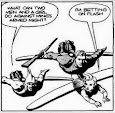U.S. title: Any Number Can Win
An ageing man is released from prison and plans to rob a seaside casino and then to retire. He partners with a younger man who had been his cellmate, also hiring the latter's brother-in-law as driver.
I had a feeling of déjà vu over this film's basic premise, and could not really remember which film had a similar one. A few days after watching it, I was randomly browsing the book 501 Must-See Movies (Bounty Books, 2004), and found the probable source of my previous encounter with this plotline: The Asphalt Jungle (1950), which I watched long ago. Here is the pertinent excerpt from that book:
Doc Riedenschneider (Jaffe), a criminal mastermind, is just out of prison and has a brilliant plan for a million-dollar jewellery heist. He recruits Louis (Caruso) as a safecracker, Gus (Whitmore) as the driver, and Dix (Hayden) as a strong-arm man to help with the raid. Initially the plan runs like clockwork but each member of the gang proves to have his own fatal flaw and each contributes to his own downfall.
The author of that synopsis is presumably Paul Frost-Sharratt, who is responsible for the book's Mystery/Thriller section. The authors of the other sections are, respectively, Ann Lloyd (Comedy, Musical and Romance), Rob Hill (Horror and Science Fiction & Fantasy), Ronald Bergan (War and Western), Chris Darke (Action/Adventure & Epic), and Cara Frost-Sharratt (Drama).
Back to Mélodie en sous-sol, it is a well made heist movie which has lots of suspense and makes for fairly good entertainment. However, the plot has some weaknesses toward the end of the movie, which I will discuss below -- warning: there will be major spoilers in what follows. Before that, one minor remark about the French title: it's really disgraceful, consisting in an unfortunate play on words. The U.S. title is no better, I'm afraid, because it simply does not describe anything about the movie except that it has a casino in it. The Brazilian title is also terrible ('Gangster in Overcoat', later changed to 'Gangsters in Overcoat') -- below I show the Brazilian poster. If you want to quit reading now, my rating is 62, so you may just skip the remainder of this text.
Spoilers ahead:
.
.
.
There isn't exactly a plot hole that I could detect, but the after-robbery events, while possessing a certain aesthetical appeal, reveal a certain lack of intelligence on the part of the robbers. They had chosen to hide the loot in a private cabin that the younger robber had rented for the season. When the older robber sees the photo of his younger partner on the newspaper, he abandons his initial plans to stay put until the heat is gone, deciding instead to flee at once with the loot. But in my opinion the assumption that the money would otherwise be safe in the cabin was unwarranted, photo or no photo. In the morning after the heist, the police was already around the swimming pool inquiring about the cabins, which suggests that the screenwriter is of the same opinion as me. The police search certainly wasn't prompted by the newspaper photo: the police didn't pay any attention to the younger robber while he was near them by the pool. Also, the poolside was perhaps not the best place for the robbers to meet; it isn't clear to me why they couldn't just choose a place away from the hotel. I would expect the police to be watching roads and train stations, not every single place in the city. Another easy precaution they could have taken would have been to move the loot to other bags (or, if in a hurry, at least provisionally put the compromised bags inside bigger ones).
Rating: 62
.png)

